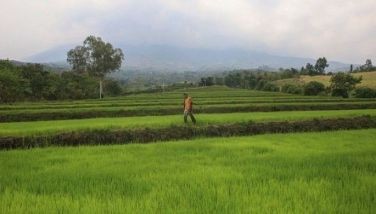The best Filipinos in the worst of times
MANILA, Philippines - The morning after typhoon “Ondoy” (Ketsana internationally) was like waking up from one’s worst nightmare. But harrowing as it was, it was a defining moment. The worst of times brings out the best in the Filipino.
With my son Jay and friend Benjie, I went at daybreak to survey the extent of the devastation. Our first stop was Sitio Ruby, beside La Mesa dam in Quezon City. Village leaders met us with tales of horror and heroism, as floodwaters rose to the rooftops of their multi-colored homes and the ensuing superhuman efforts to save self, loved ones and neighbors. Women and children were evacuated first to concrete structures with second and third floors and areas on high ground starting at noon Saturday, September 26, when it was evident that the rains would not stop. After securing their family, the men living beside the creek started fishing out children swept by the strong current. The hapless victims were mostly informal settlers from neighboring Bagong Barrio, whose shanties were no match to the sudden deluge. Most were saved, a few were lost, with no clear body count yet as they were swept downstream.
Sitio Ruby is a former slum of 5,000 residents that has been transformed into a Gawad Kalinga village. They reported no casualties. According to village leaders Tata and Joseph, it was because the neighborhood was alert and there was a lot of grace because they learned to pray as a community. In the midst of an incomprehensible calamity, incomparable in memory, they were simply grateful to be alive and to be of help to others in greater need.
That first stop started an incredible journey for me, meeting countless heroes and hearing amazing stories of our people’s indomitable spirit and capacity to care, in the sea of human suffering.
My first heroes of the day: the residents of Sitio Ruby – just coming out of danger, without food and water, but quick to organize themselves to deal with the aftermath of a devastation. They helped us set-up the relief center at the chapel for the neighboring communities, while their own homes were still in complete disarray. They knew help would come, as they had been beneficiaries in the past of generosity beyond their expectation, but the priority this time were the less fortunate outside their village. Receivers of hope were now ready to share it with others.
My next heroes are the GK Caretakers of the place, led by Gerry and Willy, members of Couples for Christ who live in exclusive subdivisions but consider the poor as family. They left the safety of their homes to be in solidarity with those who lost theirs. They were there at the crack of dawn to show the villagers that they were not alone. They knew the importance of presence in the lives of the abandoned, before relief goods or medical missions. The rich who care for the poor deserve their wealth on earth and their deposits in heaven.
From Sitio Ruby, we went to Brookside, sandwiched between Filinvest 2 and the Payatas dumpsite in Barangay Bagong Silangan, the hardest hit area in Quezon City in terms of fatalities. There I encountered more Filipinos to be proud of.
Hurriedly passing a red utility van where bodies were loaded, I trudged the muddy road on foot, resisting the urge to look – not in fear, as I helped retrieve dead bodies before from past calamities – but to refrain from being distracted in reaching our village of 300 families at the end of the road. They sent pleas for help all Saturday night, until their phone batteries ran out.
The way was littered with debris and naked children scurrying about, mixing with pigs securely tied on posts to prevent escape. Kids and pigs – precious to those with little else – brought to the safety of higher grounds in the mad scramble for dear life. Most of them came from the bottom of the gully, risking life as informal settlers along the creek that emptied itself in the Marikina River whenever it rained heavily or when the Angat dam overflowed. In their usual rhythm of life, creek dwellers would start scampering up the steep slopes whenever there was heavy downpour and immediately return to their hovels once it stopped. This time however they were not so lucky. The clouds dumped more rain in Metro Manila than Katrina that devastated New Orleans. This Barangay of forgotten Filipinos, known as squatters, lost the race for survival: 32 dead, 108 missing. It could have been more catastrophic if the storm hit at night.
I stopped myself from going down to the basketball court where more unclaimed bodies were laid out, including those of two nameless heroes who died while rescuing others.
They, and many others who lost their lives to save others, are the finest Filipinos during these trying times.
No songs will be written about them; their exploits will soon be forgotten, except perhaps by those who regained their life in exchange for theirs. But I will keep talking about them… and many others like them. Their brand of heroism defines us as a people. It is sacrifice that will make us strong as a nation, giving beyond self for others to live. Even the poorest Filipino is capable of such radical giving.
More tales of greatness greeted me when I finally reached Brookside.
I was met by the half-naked Bernard with fresh lacerations on his chest, battle wounds from this recent bout with nature for survival. With other members of the Kapitbahayan, they saved over a hundred women and children in a dramatic seven hour rescue operation, traversing through rooftops of GK row-houses which withstood strong current and served as bridge to safety; batya with babies and makeshift rafts fashioned out of banana trunks and rope were used to reach the perimeter wall of the neighboring affluent village where they were welcomed with open arms and provided food, water and dry clothes by concerned residents. It took a calamity to cross the wall of mistrust that separated the haves and the have-nots for years.
It took a tragedy for the rich to turn despair to hope and become heroes themselves.
Inside Brookside, a soup kitchen was in progress, organized by former Rotary president Jess with wife Helen, now Caretakers of the village. Like Sitio Ruby, there was no casualty in the place, and, despite extensive loss of possessions, we figured it would not take long for the community to rebound. We estimated an immediate need for 1,300 food packs and bottled water, 300 for the village, 1,000 for the surrounding areas. Under the direction of Sister Angie of the Franciscan Sisters of Charity and community volunteer Rabbi, an efficient distribution system manned by village officers was instantly put in place. We left Brookside with the promise to come back before nightfall to bring the much needed supplies.
I went to Cervini in Ateneo with my wife and children and one-year old granddaughter Tala in tow, which turned into a beehive of activities as volunteers and donations poured in as soon as university president Fr. Ben sounded the call. Relief operations had to be moved to the covered courts to accommodate the swelling crowd.
Tragedy brought out the innate idealism of youth. After all nations in the past were built by their young patriots who fought their wars. I saw that afternoon in this exclusive school many young heroes -from sheltered homes, with parents who possess wealth and power- coming out of their closet. I saw in their faces the great country that we are not yet… but soon will be… if we keep this up. Greatness will come to us once we get out of our artificial bubble of affluence to be in the real world of the abandoned and the neglected.
We went back to Bagong Silangan in a convoy of four vans loaded with supplies, passing by for my British son-in-law Dylan, who bought bottled water and canned goods at newly opened Shopwise. The line to the cash register took him two hours, as shelves were being emptied by eager shoppers, not in a frenzy of panic buying to hoard for self, but to help others. This was another amazing phenomenon.
The mood of the moment was inclusive… as it should always be. The pain of every Filipino is our pain.
We stayed at Brookside until nightfall. The need was immense but the spirit was hopeful. They knew that they now have a lifeline with brethrens and friends who have a covenant with God not to abandon them. Sleep came late, but it was peaceful.
I was up early the following day to join QC Mayor Sonny at the flag raising ceremony at the city hall, where I signed an agreement with generous land donor Sandra to relocate scavengers living dangerously in the dumpsite of Payatas. The effort of local government to do land-banking , 62,000 home lots to-date, to reduce squatting and transform slums into viable communities with us, will lessen their burden with the poor when calamity strikes. I see effective leadership in this city where I live, not only in the wide streets and improved facilities due to better fiscal policies and reduced corruption, but in their new thrust to do ground-up community development work, starting in the 84 GK villages and rapidly increasing. I hope this initiative will continue after next year’s election.
There is great power in public-private partnership. The private sector is a sleeping giant of patriots and heroes waiting to be awakened by great causes and great leaders.
I saw many of them at the RFM gym where Operation Walang Iwanan was in progress, an initiative of GK head Luis with the Concepcion brothers, Joey and John. They were there to meet the immeasurable need for immediate relief head on, believing in the Filipinos immense capacity to care. They were right. Thousands of volunteers came – rich and poor alike, from nearby plush villages and GK communities. They came - and opened the floodgates of generosity unseen by many before. In six days of festive nobility, over 6,000 volunteers processed and delivered 182,000 food packs, with thousands more on the ground. Donors who came, including top CEOs, marveled at the fast and efficient system when there is synergy and convergence. AFP Chief Bong, a friend of GK since its early days, provided us with seven military trucks and escorts to reach the most number of victims in the most difficult to reach areas of Marikina, Cainta, Taguig, Pasig and Pateros. GK communities in those places, in coordination with the LGU, became effective and peaceful sites for distribution.
It is heartening for us to experience the extensive goodwill that we have planted on the ground and patiently nurtured over the years. We have the massive platform now to expand our reach at the relief stage and later on, in the more challenging work of rehabilitation and rebuilding.
With the help of the global community that is starting to pour in, we will continue our work of transformation until the Filipino ceases to be a perennial victim in his own country.
That will happen soon if every Filipino decides to be a hero… now. Bawat Pilipino Bayani… Ngayon.
- Latest
- Trending





























